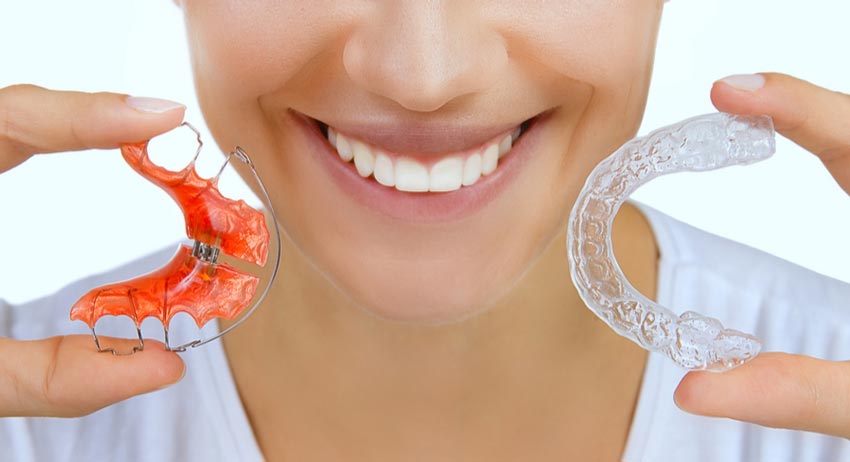
So, you have gone through perhaps 4-6 months of wearing your clear aligners and are now rocking a beautiful set of straight teeth. You may now be wondering what you need to do next.
Many people will tell you about how it is vital that you wear a fixed retainer after wearing braces or clear aligners in order to keep your fabulous new smile looking just as good now the treatment is finished. But is it really that important? What happens if you do not get a retainer after the aligner treatment?
Yes. You will need a retainer. Here is why
Your teeth will always be shifting about in your mouth, as a response to forces applied to them. Give your teeth a gentle wiggle or push – you will feel a little bit of movement. Without a fixed retainer after completing your invisible aligner treatment, you will end up almost back at square one eventually and will have wasted your money and hard work.
The forces come from your cheeks, tongue, lips and jaw. These all move when you talk, eat, drink, yawn, sing, sleep, sneeze, cough and breathe. It does not matter how long you wear braces or aligners, your teeth are never rigidly fixed into place.
For many years, it was thought that retainers were unnecessary. Orthodontists did not recommend them as they thought that once the alignment treatment was completed, that was the job done. That was until adults, who had worn braces without following them up with a retainer, started complaining that their teeth were now crooked again. Had they worn and are retainers following their initial treatment, they would still have beautifully straight and even teeth.
Fixed retainer
A fixed retainer can be ideal for holding your newly aligned teeth in their new places, especially the bottom front six teeth. They are usually pieces of wire that are glued to the back of your teeth and are adjusted according to your bite. If you struggle to stick to the guidelines surrounding removable retainers (which we will discuss a bit later on), your orthodontist may recommend that you have a fixed retainer applied to your teeth.
A fixed retainer can be worn permanently, only being removed if it irritates your gums or creates a significant build up of plaque or tartar.
The good thing about a fixed retainer si that because it is applied to the back of the teeth, no one else knows it is there and eventually, you will forget it is there too. They are not damaged easily, do not affect the way that you speak and because it is always there, your teeth are guaranteed to stay in place.
However, as with anything, there are downsides to a fixed retainer.
Brushing and flossing your teeth around a fixed retainer can be more challenging and take a lot more effort than if you were not wearing one. If not cleaned properly, you are at risk of cavities, tooth decay and severe gum disease, all of which can lead to tooth loss.
It can also rub against your tongue, and if the wire breaks or the bond comes off, it can be quite uncomfortable until you can get it fixed. It can prevent you from eating certain foods or be damaged by them – hard apples, chewing gum, toffee, and tough pieces of meat can bend them out of steak and off the menu for many people. Food and drink that is high in sugar or similar additives can also weaken the bonds.
What is the alternative to a fixed retainer?
There is an alternative to the traditional fixed retainer: the removable retainer. These are great because there is nothing permanently attached to your teeth and are generally more hygienic as they can be cleaned quickly and easily. However, for them to actually work, you need to wear them for the recommended amount of time.
In the first few weeks after completing your aligner treatment, you will need to wear a removable retainer almost all of the time for it to work effectively and keep your teeth straight and in their rightful place. This period should last around two to four weeks, and they should only be removed to eat or brush your teeth. After that, you may be able to wear them just at night – but every night – for six months or so, before dropping down to a couple of nights a week. It is important to wear them as instructed and have them checked and adjusted as appropriate – otherwise, you will lose the results of all of your hard work so far. They are generally better on the upper teeth, as you may bite down and damage ones on the bottom set.
Many people who have aligner treatment opt for removable retainers afterwards as they are easier to clean both the appliance and their teeth and gums. Some people prefer them for cosmetic appearances as well – they can be easily taken out for special occasions.
The biggest downside of a removable retainer is compliance. You may think that you are going to be really disciplined when it comes to wearing it, but when it comes to it – will you remember to or want to put it in every night? Many people fall out of the habit, thinking it won’t hurt ‘just this once’, and before they know it, it has been months since they wore it and their teeth have irreversibly shifted.
The takeaway from this is that yes, you do need to wear a retainer after completing your invisible aligner treatment if you want to stop your teeth from moving. However, whether you opt for a fixed one or a removable one is entirely up to you. Spend some time talking to your provider and orthodontist and checking out the advantages and disadvantages of each one before making your decision

